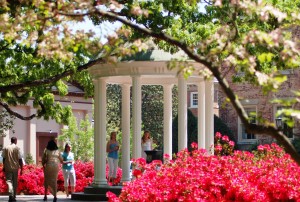 Thank you for visiting Orange NCGenWeb! Please note that we are not part of Orange County government.
Thank you for visiting Orange NCGenWeb! Please note that we are not part of Orange County government.
Orange County NC was created out of parts of Bladen, Granville, and Johnston counties in 1752. At that time, it comprised a large section of the middle of the NC colony, extending halfway from the VA line to the SC line. It was named for the infant William V of Orange. His mother Anne, who was a daughter of King George II of England, was the dowager princess of the Dutch Republic.
At the time that the county was formed, there were 5 Native American tribes living in the area.
As other counties were created out of parts of Orange’s territory, these counties were created wholly out of Old Orange: Chatham (1771), Caswell (1777) and Person (created out of Caswell in 1791), and Alamance (1849). Other sections of the old county were combined with parts of other counties to create: Guilford (1771) –which gave birth in turn to Randolph (1779) and Rockingham (1785) — Wake (1771), Durham (1881), and Lee (1907). After all of this, Orange County was just a fraction of its original size. This PDF of North Carolina County Development is helpful in following North Carolina’s county changes.
The county seat for Orange is Hillsborough, founded in 1754 on land where the Great Indian Trading Path crossed the Eno River. Hillsborough is an old and interesting town that was the seat of one of the colony’s superior courts until counties were allowed to have their own superior courts. Consequently, it was a center of much colonial activity. It first was called Corbin Town, then Childsburgh, and finally the town’s name became Hillsborough in 1766.
Hillsborough was the scene of many colonial confrontations, including some of the confrontations of the Regulator Movement, also known as the War of the Regulation. This was a rebellion of farmers and other ordinary landowners against the royal administrators who were often corrupt. The movement escalated into the Battle of Alamance in May 1771. Governor Tryon and his forces retaliated with the hanging of six Regulators at Hillsborough in June 1771.
Hillsborough was the home of the state legislature during the Revolution, and it served as a military base for Cornwallis in 1781. NC delegates to the Constitutional Convention met in Hillsborough in 1788 to vote whether to ratify the document, first voting “no” because of anti-federalist concerns.
 In 1789, the North Carolina General Assembly chartered the University of North Carolina. The first cornerstone was laid in 1793, near the ruins of a chapel, and classes began in 1795. The town of Chapel Hill was founded in 1819 and chartered in 1851. UNC is the oldest state-supported university in the US, and the campus now called UNC-Chapel Hill is the flagship of the UNC system, with 16 locations across the state.
In 1789, the North Carolina General Assembly chartered the University of North Carolina. The first cornerstone was laid in 1793, near the ruins of a chapel, and classes began in 1795. The town of Chapel Hill was founded in 1819 and chartered in 1851. UNC is the oldest state-supported university in the US, and the campus now called UNC-Chapel Hill is the flagship of the UNC system, with 16 locations across the state.
The community first known as West End became known first as Venable and then as Carrboro. It grew up around the State University Railroad, a main transport system for the area. This area later became the home for mills owned first by Thomas F. Lloyd and later by Julian Shakespeare Carr, and for a hardwood cross-tie industry based on local timber.
Today, Orange County remains a vital area and community, serving as the home to UNC-Chapel Hill and its complex of undergraduate and graduate and professional schools. Also, Chapel Hill is one of the three corners of the Research Triangle, an area established in 1959, home to many research laboratories and corporate offices which located between Chapel Hill (UNC-CH) and Durham (Duke University) and Raleigh (NC State University).
Orange County has seven townships: Bingham, Cedar Grove, Chapel Hill, Cheeks, Eno, Hillsborough, and Little River. There are three incorporated municipalities located primarily in Orange County: Carrboro, Chapel Hill, and Hillsborough. Parts of the City of Mebane in Alamance County, and Durham in Durham County, extend into Orange County. There are also many unincorporated communities: Blackwood, Buckhorn (aka Cheeks Crossroads), Caldwell, Calvander, Carr, Cedar Grove, Dodsons Crossroads, Dogwood Acres, Efland, Eno, Eubands, Fairview (Hillsborough), Hurdle Mills, Laws, McDade, Miles, Oaks, Orange Grove, Piney Grove, Rougemont, Schley, Teer, University (formerly known as Glenn), and White Cross.
Orange County is an diverse and interesting mix of old historic sites, beautiful rural and suburban areas, and lively towns and cities enriched with the social and cultural benefits from large university populations.
[sources: Wikipedia articles and the Orange County website]



